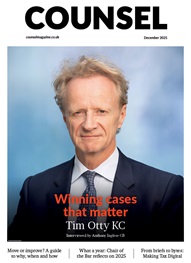*/
Nine out of ten Silks are men and it will take 50 years to achieve gender equality, according to the latest figures from the regulator.
Women account for 36.5% of the practising Bar, up by 0.6% since 2015, and only 13.7% of QCs, according to the annual Report on Diversity at the Bar from the Bar Standards Board (BSB).
The figures showed there continues to be a disparity between the total percentage of black and minority ethnic (BAME) barristers across the profession (12.2%), and the percentage of BAME QCs (6.4%).
While there remains an over-representation of barristers from fee-paying schools: 10.7% of the profession compared to 7% of the population.
At the current rates of change, the report said it would take over 50 years for women to make up 50% of QCs, and nearly twice as long for BAME barristers to make up 16% of QCs, drawing them in line with the wider population of England and Wales.
The BSB said there continued to be a low response rate to diversity data, with the majority of questions answered by approximately one-third of the profession.
Bar Chairman, Andrew Langdon QC, said: ‘One of the key challenges is to get women to stay in the profession for longer, widening the pool of talented women available so that more can apply for Silk and judicial appointment.
‘We also need to increase the number of BAME barristers who become QCs and go to the bench, and to enable more state school students to join the profession. If we succeed, we will have a legal profession and judiciary that reflect the communities they serve.’
Nine out of ten Silks are men and it will take 50 years to achieve gender equality, according to the latest figures from the regulator.
Women account for 36.5% of the practising Bar, up by 0.6% since 2015, and only 13.7% of QCs, according to the annual Report on Diversity at the Bar from the Bar Standards Board (BSB).
The figures showed there continues to be a disparity between the total percentage of black and minority ethnic (BAME) barristers across the profession (12.2%), and the percentage of BAME QCs (6.4%).
While there remains an over-representation of barristers from fee-paying schools: 10.7% of the profession compared to 7% of the population.
At the current rates of change, the report said it would take over 50 years for women to make up 50% of QCs, and nearly twice as long for BAME barristers to make up 16% of QCs, drawing them in line with the wider population of England and Wales.
The BSB said there continued to be a low response rate to diversity data, with the majority of questions answered by approximately one-third of the profession.
Bar Chairman, Andrew Langdon QC, said: ‘One of the key challenges is to get women to stay in the profession for longer, widening the pool of talented women available so that more can apply for Silk and judicial appointment.
‘We also need to increase the number of BAME barristers who become QCs and go to the bench, and to enable more state school students to join the profession. If we succeed, we will have a legal profession and judiciary that reflect the communities they serve.’


Chair of the Bar reflects on 2025
AlphaBiolabs has donated £500 to The Christie Charity through its Giving Back initiative, helping to support cancer care, treatment and research across Greater Manchester, Cheshire and further afield
Q&A with criminal barrister Nick Murphy, who moved to New Park Court Chambers on the North Eastern Circuit in search of a better work-life balance
Revolt Cycling in Holborn, London’s first sustainable fitness studio, invites barristers to join the revolution – turning pedal power into clean energy
Rachel Davenport, Co-founder and Director at AlphaBiolabs, reflects on how the company’s Giving Back ethos continues to make a difference to communities across the UK
By Marie Law, Director of Toxicology at AlphaBiolabs
Are you ready for the new way to do tax returns? David Southern KC explains the biggest change since HMRC launched self-assessment more than 30 years ago... and its impact on the Bar
Professor Dominic Regan and Seán Jones KC present their best buys for this holiday season
Oscar Davies shares their lessons learnt
Little has changed since Burns v Burns . Cohabiting couples deserve better than to be left on the blasted heath with the existing witch’s brew for another four decades, argues Christopher Stirling
Pointillism, radical politics and social conscience. Review by Stephen Cragg KC